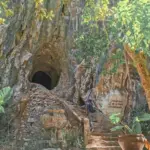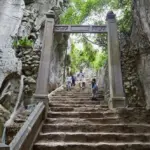Exploring the Caves of Marble Mountains in Da Nang by Ovuigo
The Marble Mountains (Ngu Hanh Son) rise above the cityscape of Da Nang, forming one of Central Vietnam’s most iconic natural landmarks. These five dramatic limestone and marble hills—each named after an element: Thuy (Water), Moc (Wood), Hoa (Fire), Kim (Metal), and Tho (Earth)—are steeped in mystery, legend, and spirituality. The mountains house a labyrinth of caves, ancient shrines, Buddhist sanctuaries, and historic artifacts, making cave exploration here an unmissable adventure for travelers seeking both natural wonder and cultural immersion.
Marble Mountains are easily accessible, located just south of Da Nang city center. Entry tickets are required for some caves and temple complexes, with prices starting at 40,000 VND for adults and 10,000 VND for children. An elevator to the main summit area is also available for a small additional fee.
Walking through winding stone stairways, you’ll encounter dramatic grottoes, ancient cave temples, and spiritual art set among towering stalactites. The geological structure provides a cool microclimate and natural echo chambers—amplifying every step and even the faint chants of Buddhist monks. To witness cave exploration at its best, visit early in the morning for soft daylight filtering through rock skylights, or in the late afternoon, when lanterns flicker in shadows cast by Buddha statues. Ovuigo.com recommends reserving at least half a day to marvel at this spiritual site, unwind by dragon-carved altars, and climb to viewpoints overlooking the city and Han River.

History and Spiritual Significance of Da Nang Caves
The Marble Mountains’ caves have been revered as sacred for centuries. Local legends claim the mountains were formed from a dragon’s egg, making them a powerful spiritual symbol. The caves became centers of pilgrimage for Buddhists and worshippers alike—attracting those seeking peace, healing, or divine wisdom. Over the centuries, dynastic rulers, scholars, monks, and everyday pilgrims came here, etching carvings and cave paintings into the marble, crafting intricate altars, and hiding precious artifacts during times of war.
The Ngu Hanh Son complex shelters several ancient Buddhist sanctuaries and mysterious shrines, housing statues, incense urns, and ritual chambers. The echo of chanting and drumbeats during prayer ceremonies fills the cool air, inviting visitors into a meditative atmosphere. Am Phu Cave, styled as an allegory of the Buddhist afterlife, is famous for its cave painting murals depicting hell, karma, and rebirth—serving as an interactive teaching tool for generations. Meanwhile, Huyen Khong Cave, with its lotus-shaped skylight, became home to monks seeking spiritual enlightenment and a convenient refuge for resistance fighters during the Vietnam War.
The Marble Mountains—listed as a national monument—continue to draw thousands of pilgrims every year, especially during religious festivals. Buddhist monks still preside over ceremonies, tending statues of deities like the Buddha and Bodhisattva. Guided cave tours in Da Nang often provide fascinating insights into these spiritual practices, as well as the geological origins and cave-shrine relationships unique to this region.

Notable Caves and Sites: Huyen Khong Cave, Am Phu Cave, and Linh Ung Pagoda
Among the countless grottoes, several sites stand out both for their scale and significance:
- Huyen Khong Cave: Often called the spiritual heart of Marble Mountains, this vast chamber is illuminated by a dramatic natural skylight. Worshippers gather here before ancient Buddha statues, surrounded by centuries-old incense smoke. The cool air and soft rays create an atmosphere ripe for meditation. Accessing Huyen Khong Cave involves a climb up stone steps, but the reward is a sense of peace, resonance of prayers, and unforgettable panoramic views from nearby lookouts. Find it on Google Maps.
- Am Phu Cave: Known as the “Hell Cave,” Am Phu Cave is famed for its intricate system of tunnels, subterranean chambers, and Buddhist sculptures that illustrate the realms of the underworld. Following winding passageways, visitors witness graphic representations of karmic retribution intermingled with hopeful messages of redemption. Creeping through narrow corridors and past lurid statues, you’ll emerge at an altar bathed in light—symbolizing the path from darkness into enlightenment. Am Phu Cave is suitable for adventurous visitors and remains one of Vietnam’s most unique cave experiences. See its map location.
- Linh Ung Pagoda: Set atop Thuy Son, this Buddhist temple overlooks the Marble Mountains and the city below. Established in the 19th century, Linh Ung Pagoda is renowned for its grand halls, ancient statues, and intricate altars. Pilgrims and casual travelers alike pay respects at the towering Buddha statue, enjoying the tranquility of lotus ponds and fragrant blossoms. A must for anyone seeking insight into local Buddhist rituals. View on Google Maps.
All these sites are included in the main Marble Mountains ticket, so plan to explore at your own pace or with a local guide to fully appreciate their cultural importance.

Geological Features: Limestone Formations, Stalactites, and Skylights
Marble Mountains are a textbook example of limestone karst topography—a landscape formed over millions of years as rainwater passed through cracks in the earth, dissolving soluble minerals and leaving behind caves, arches, and towers. The underground network features dramatic caves and tunnels, many with rich deposits of marble and rare minerals. Inside, stalactites hang in melody from the cave ceilings, while stalagmites thrust upwards from the cool stone floor, sometimes joining to form towering natural columns rivaling any skyscraper for age and grandeur.
Distinctive skylight openings punctuate the caves, creating shafts of light that illuminate echoing chambers and reveal ancient cave paintings or Buddhist inscriptions. The airflow patterns in these caves keep the climate cool year-round and support a stable bat population—look for the subtle patterns they create on mineral-rich walls. Marble sculptors continue to quarry stone from the region, transforming it into intricate dragon and lotus motifs that adorn temples and shrines throughout Central Vietnam.
To appreciate the geology firsthand, peer up at the ceilings for glistening mineral threads, pause in the quiet to notice the shift in air temperature, and run your hand over centuries-old inscriptions—a living history carved in stone.
Tourism Experience: Accessibility, Guided Tours, and When to Visit
Marble Mountains’ main entrance is located at 81 Huyen Tran Cong Chua, Ngu Hanh Son District. Step-by-step, here’s how to maximize your visit:
- Arrive early morning (7 a.m.–9 a.m.) or late afternoon (after 3 p.m.) to avoid crowds and capture the best light for photos.
- Purchase your entrance ticket at the main gate (40,000 VND adults/10,000 VND children). Elevator access is available for 15,000 VND.
- Wear sturdy shoes for climbing stone stairs and exploring slippery passages.
- Hire a local guide (ovuigo recommends only experienced, certified guides) if you want deeper historical and geological context—look for tours advertised as “guided cave tours in Da Nang.”
- Carry water, a hat, and light clothing—cave temperatures are mild, but outside can be hot.
- Avoid entering caves alone or during heavy rain to minimize risk from slippery paths.
Tours often last three to four hours. Visit during Da Nang’s dry season (March–September) for the safest, most comfortable conditions. Most services, rest stops, and souvenir stalls are open daily. For a more spiritual experience, time your trip with lunar festivals, when rituals fill the caves with lantern light and the gentle hum of community prayer.
**We don’t run tours — we craft experiences. Each journey is a story written just for you, designed for those who wish to explore Vietnam slowly, deeply, and meaningfully. No fixed itineraries. No crowds. Just you — and the moments that truly matter. *WhatsApp us at +84868319161* to plan your meaningful, tailor-made adventure.**

Nearby Attractions: Son Tra Mountain, Hoi An, Ba Na Hills, and My Son Sanctuary
Make your Marble Mountains adventure the centerpiece of a broader Da Nang itinerary:
- Son Tra Mountain (Monkey Mountain): Located northeast of Da Nang, this protected peninsula is home to lush forests, wild monkeys, and the striking Lady Buddha statue at the Linh Ung Pagoda. The mountain offers panoramic city and sea views. Google Map link.
- Hoi An: This UNESCO World Heritage town, famed for its lantern-lit streets and ancient trading port, lies just a short drive south. Meander through rice fields, colorful markets, and riverside cafes.
- Ba Na Hills: A mountaintop resort west of Da Nang, known for its Golden Bridge held aloft by giant stone hands and its French-style village. Visitors can reach it by an impressive cable car ride. Ticket price: about 900,000 VND. Google Map.
- My Son Sanctuary: Explore the red-brick ruins of this ancient Cham civilization site—a center of Hindu worship set among jungle-clad mountains. Entrance fee: 150,000 VND. Google Map.
- Hoi An: Google Map.
- Hue: The former imperial city to the north, famous for its citadel and royal tombs. Google Map.
- Lang Co Beach: White sandy beaches stretch alongside turquoise lagoons and fishing villages, perfect for a tranquil escape. Google Map.
Whether you’re drawn to ancient shrines, hidden caves near Da Nang city, or breathtaking natural vistas, Central Vietnam rewards curiosity and slow exploration. Reach out to ovuigo for bespoke guidance, and stay overnight in one of our carefully curated homestays to deepen your travel experience. For exceptional accommodations, discover The Manor Hoi An, Hola 1, and Hola 2.




